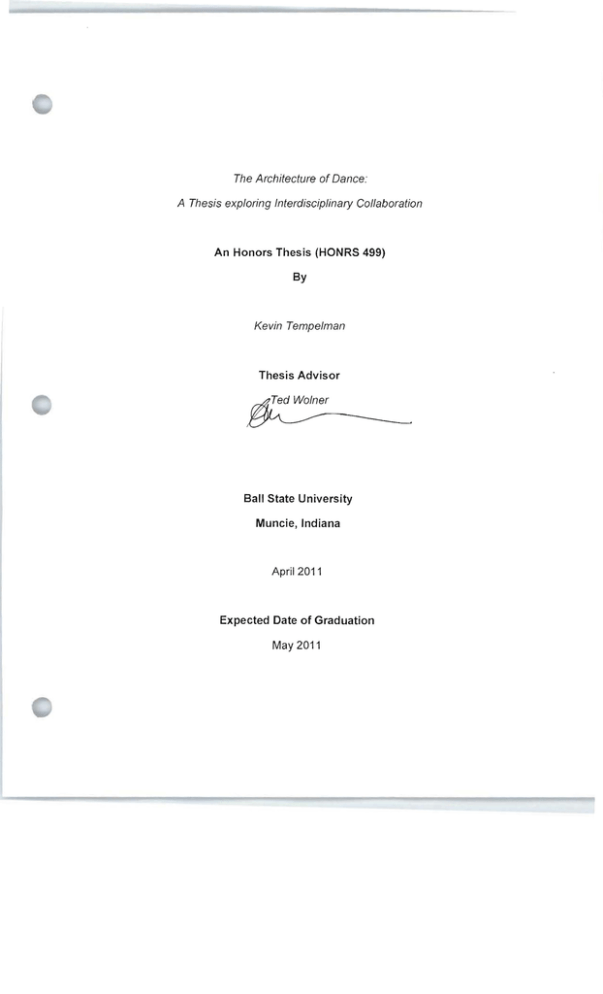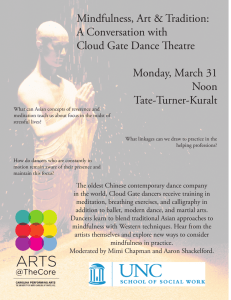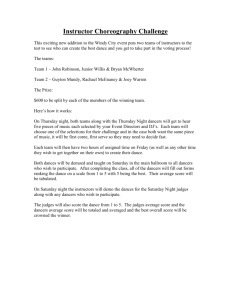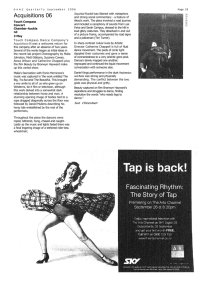Document 10943538
advertisement

The Architecture of Dance: A Thesis exploring Interdisciplinary CoJ/aboration An Honors Thesis (HONRS 499) 8y Kevin Tempelman Thesis Advisor 8all State University Muncie, Indiana April 2011 Expected Date of Graduation May 2011 Abstract: Architecture and dance are not typically thought of as having much in common. Architects design buildings which are stationary and solid, while dancers choreograph movements that create fleeting moments of beauty. Typically, architecture and dance do not overlap. However, artists are beginning to realize correlations between the two and to explore those relationships through interdisciplinary collaborative projects. In today's professional world there is an increasing demand for collaboration on projects, even collaborations with professionals from other fields. I teamed up with Ellyn Sjoquist, a dance performance major at Akron University to work on a performance in which architecture and dance were brought together. We presented our work at a final performance and presentation at Akron University on April 8. Through our collaboration, we explored how architecture and dance can work together and we discovered the values of interdisciplinary collaboration firsthand. Acknowledgements: I would like to thank my advisor Ted Wolner of the Architecture Dep~rtment. His immense knowledge of architecture and the fine arts gave me new insights into the role and possibilities of architecture. I would also like to thank Ellyn Sjoquist and all her wonderful dancers from Akron University. This project could not have happened without all of their dedication and cooperation. 2 At first glance, one would not think that the architect and dancer have much in common. Architects deal with structure and edifaces, striving for permanence of form. Dancers work with gestures and movements, resulting in fleeting moments of beauty. The two fields do not typically overlap in the professional realm. Architects work in a studio or on a drawing board while dancers perform on stage or in a theatre. And so, when I - an architecture major - and my good friend Ellyn Sjoquist - who is a dance performance major at Akron University - talk about our respective work, we are always surprised at the similarities that exist between architecture and dance. We have always been intrigued by the finer aspects of each other's expertise, but in the fall of 2009, Ellyn was assigned a project that led us to explore these similarities further. The assignment was to observe the rhythms and forms of a building and to choreograph a short dance inspired by the architecture. Ellyn contacted me to get some insight from an architecture student and to ask what types of things she should be looking for in this assignment. Through the conversations we had during this assignment, we noticed that there were quite a few similarities in the creative processes of both architecture and dance. We were both very excited to explore this concept more thoroughly. We proposed a project that used Ellyn's senior choreography project as a base for an interdisciplinary collaboration. She would choreograph a dance and I would design and build an architectural installation inspired by a common concept. We chose the theme of wavelengths, an idea that stemmed from an experience we shared during our freshman year and intrigued both of us. At the end of our projects - April 2011 - we would put our two pieces together for a final performance and presentation at Akron University, in which we would discuss our individual creative processes and our experiences through collaboration. Through this joint thesis, our intentions were to explore the similarities in architecture and dance and to discover how the two can complement each other, and also to convey the benefits of interdisciplinary collaboration . Although the overlap between architecture and dance has been a fairly unexplored area, our collaboration is not the first of its kind. Other artists have begun to realize the creative potential in collaborative projects . We started by researching other similar projects where architects and choreographers collaborated on a single project. Through this research, we found that there are many similarities between architecture and dance that are not overtly evident on first observation . The first collaboration I found was the design of the School of American Ballet Studios. Choreographer and Director Peter Martins wished to expand the studio space of the school and approached architect Elizabeth Diller of the firm Diller Scofidio + Renfro . As a concept for the design of the studio, Diller used the same language as a dancer in motion to describe her work. She designed a studio that would float above the existing space and is supported by three arching steel beams (Images 1,2) . The construction seems to soar effortlessly, "like a ballerina in flight," but it rests on technical finesse as essential as a dancer's technique. Of the collaboration, Diller said she was struck by the similarities between the two disciplines. Diller said "We kind of do the same thing. We're interested in bodies and space, and we're interested in overcoming the laws of gravity." The second example I researched was a partnership between Peter Martins, again of the New York City Ballet and architect Santiago Calatrava . Martins asked Calatrava to design a series of backdrops for five different choreographers for the Spring 2010 season. I focused on 3 the set designed for Martin's piece, named "Mirage." Calatrava's set was a large movable structure that began as two joined arches taking up center stage. Throughout the ballet, the arches rose, came together, floated apart, and turned to compliment to movements of the dancers (Image 3) . Calatrava's installation is bathed in colored lights throughout the piece to mirror the musical cues, and the shadows it casts on the stage became a part of the dance itself (Image 4). The intent of both Calatrava and Martins was that the architecture and the choreography both took on a complimentary role and came together to make a comprehensive project, where both sides were responded to the presence of the other. The artists did face some challenges during the project. Calatrava specifically was challenged with designing for the confines of the stage and building a full scale, gravity defying structure . On top of this the architecture needed to be simple enough to install and dismantle quickly. Contextually, the set needed to be dramatic, but not so much that it upstaged the dancers. Compromise was critical between the architect and choreographer. Calatrava had to adapt his concepts to meet the vision of Martins and the choreographers at times repositioned their dancers to accommodate the set. This collaboration was really influential on my work this semester. First of all, it was a nearly identical concept, where an architect designed backdrops for the choreography. I also had some of the same intent as Calatrava, using qualities of lighting and materiality to create a specific effect. Also, I learned a lot from this collaboration, as Ellyn and myself would face many of the same challenges as Calatrava and Martins did . After research, I moved into the schematic design stage of the project. For inspiration, I observed the behavior and qualities of wavelengths that occur in the natural world. I was particularly inspired by watching waves crash onto the shore. A single wave starts small and then builds up gradually, until it peels over and breaks on itself in a final dramatic climax (Image 5) . Through my installation, I wished to recreate the same dramatic feel, placing the dancers right under the wave at the moment of breaking. I began to explore this concept through a series of sketches which explored qualities of waves and various forms and themes for the set design (Image 7). I also watched videos of Ellyn's dance rehearsals and tried to capture specific poses or motions in sketch form (Image 6) . These explorential drawings helped me identify themes in the choreography which I was then able to compare with my intentions for the set design (Images 8,9). The first major decision I had to make was a direct result of the observations I made while observing the dancers during rehearsal. The dance team grew to eight members and I saw that they needed every inch of stage space for their performance. I responded to this by choosing to design an overhead element as the set piece. This would free up the maximum amount of floor space and allow the dancers to move about the stage unimpeded. Once I had made this decision, I built a scale model of the stage including the back wall, side curtains, and lighting grid and built a series of models of my installation. Through these models, I was able to determine the relative size and shape of the installation, as well as materials and overall aesthetics. One of the biggest challenges now was to determine how my installation would engage the dancers. In my last model, I manipulated the form to hang asymmetrically over the stage, mirroring the positions of the dancers. I also gauged a rough estimate of how high or how low the installation would hang in different zones so that it felt it 4 was still a part of the performance and still allow the dancers room for movements (Images 10,11). Now that the design was mostly determined, I moved into the construction phase of the project. Choosing the materials and methods of construction for the installation was by far the most challenging aspect of my project. The materials would need to be chosen for their size, weight, aesthetic qualities, and cost. I needed the installation to be flexible enough to bend and twist but also sturdy enough that it would not collapse. Also, the materials would need to cover a distance of 20 x 20 ft, the size I had determined for the installation. After some exploration with wood and steel conduit, I chose PVC pipe as the best material for the grid part of the installation. PVC pipe is available in 10 ft sections at any chain hardware store and comes in %" diameter at its thinnest size. With these dimensions, the PVC is very flexible and I could use its natural deflection to get the curvatures I wanted without any pre molding or difficult fabrication. Also, PVC is a very sturdy material and gives a lot before it fails structurally. To construct the grid, I used PVC sleeves to join two 10' sections into one 20' long member. Then I laid out the PVC in my predetermined 20' X 20' grid, composed of 5' x 5' bays. I marked each point of intersection and used the drill press in the CAP woodshop to drill a hole just slightly larger than the 5/8" bolts I would be using as jOiners. the piece would be hanging overhead, the joints were the key piece to the structural integrity of the installation. The strength of the bolts would be more than adequate to ensure the joints would not fail. At four points of attachment, an eye bolt was used in place of the regular bolt (Images 14,15). To hang the installation, I used 3/16" Wire Rope that would loop through the eye bolt and tie around the lighting grid. Wire rope is very strong and provided more than enough strength than I needed to suspend my lightweight installation. The tulle mesh would be attached using zip ties that would attach to the PVC grid before being hung in place (Images 16,17). As a last aesthetic decision, I spray painted all the PVC sections silver. This would mask the materiality of the PVC and give the piece the sleek, ephemeral look I wanted. Also, I hoped that a metallic sheen would catch the color of the lighting we would be using and reflect it. On April 7, the day before the performance, I packed all my materials into my small Cavalier and drove the five hours to Akron. Ellyn had reserved the space and I had all day to assemble and install my piece. The assembly of the grid and attaching the tulle was relatively quick and easy. The most difficult and intense part of the installation was the suspension of the piece. It was much too large to handle with two people, so Ellyn and I recruited the help of the theatrical design class. With their help arid movable scaffolding, we picked up the piece and suspended it one pOint at a time (Images 18,19). Once it was up, I was able to adjust the height of each pOint to get the desired shape in the grid. Much of the tulle had stretched or torn during the hanging of the piece, so several hours were spent reattaching the tulle and filling in any gaps. The final step of the collaboration was the lighting design for the performance. After I had designed and installed the architecture and Ellyn had choreographed her piece, the lighting was an opportunity for us to work on the same project and tie the architecture and dance together. The lighting added another layer of meaning onto the performance. We used mainly blue, green, purple, and white gels on the lights as a color palette and added them on in increments as the performance progressed. At times, the lighting calls attention to the 5 architectural installation and it becomes the focus . As the dancers pick up, the lights come up brighter to light them and the installation becomes a backdrop . As the performance winds down, the installation is once again emphasized before it ends in darkness. For the lighting, we learned how to work the lighting board and I also learned about the different types of lighting (Images 20,21) . To light the piece we used Shin lighting and head lighting, which comes in from high and low on the sides (Image 22), house lighting, which lights the entire theatre, the blue overhead and the lavender overhead lighting. We learned how to work the switchboard to pull up the lights we wanted at the times we wanted, and recorded all of it for a specialist to work during the performance . The day of the final performance and installation was extremely exciting and gratifying . To finally see the architecture and choreography together was an immensely satisfying end to the collaboration . The final design was a large grid which was draped with mesh and hung over the performance space. It curved and arched based on the points and heights of attachment, creating varying levels of enclosure and spatial qualities in the performance area . The contours of the installation seemed to trace the motions of the dancers beneath . It was bathed with different colored lights throughout the performance so that the installation mirrored the energy levels of the dancers and the piece as a whole. After all the hard work, both of us got to enjoy the performance and see the project come to fruition. We followed up the performance with a team presentation in which we discussed each of our processes and what we learned through the collaboration. The choreography, architecture, and discussion were all very well received . As I mentioned before, our intentions through this joint thesis were to explore the similarities between dance and architecture as complimentary art forms and to convey the benefits of interdisciplinary collaboration . While we both felt we were successful in achieving these goals,that is not to say we did not face challenges during our work together. One of the biggest challenges of this collaborative endeavor was the simultaneous work occurring on both sides of the project. While in other collaborations, either the architecture or the choreography was in place and the other party responded to it. In our exploration, the architectural design took place alongside the choreographic work. Therefore, keeping one another informed of what the other was doing was crucial to the project. To keep each other informed, we used various forms of technology. Email, digital photography, video chatting, and live streaming all made this endeavor possible. Not only were we able to share our progress over the distance from Muncie to Akron, but we were able to this instantaneously. Ellyn used the in-studio media center to film her rehearsals and even live video stream so I could watch her progress. I used the 3D Modeling program Rhino to make fast digital renderings and digital photography to photograph models which I then shared with Ellyn and her dancers. We also used Skype Video Chat on a regular basis to discuss our project and progress. Without having technology available to us, the collaboration would not have been possible. Collaboration is an increasingly important concept in today's professional field, especially in design oriented professions. More and more projects are becoming team driven, thriving on the concept that more minds bring more ideas to the table. More than that, interdisciplinary collaboration is finding its place in the design profession . According to Design 6 Intelligence, interdisciplinary collaboration is one of the 25 trends transforming architecture and design. In the article, they predict that "teams of unaffiliated experts representing a wide range of technical and creative skills will excite clients to rethink what's possible." It is important that students of design are well practiced in this current trend . The collaboration we worked on between dancers and choreographers would have been unheard of in the past. Today, however, it is seen as a valuable experience which encourages both sides to push their creativity to the limit. Also, good designers must be well versed in many different topics. To design for a client, one must know what their needs are. In the book Space for Dance, the authors underline the need for architects and builders who are familiar with dance and its needs. They state "What builders need, and what has so often been lacking when theatres are constricted are persons able to define the art of dance and its needs for architects and designers able to translate those requirements into buildings that work for performers and patrons ." This is as true for theatre and dance as it is for any client. In order to design buildings and spaces that work for the client, designers must know the needs of who they are designing for. Interdisciplinary collaboration is a concept that many professional fields are just beginning to realize the creative potential of. Through our work, Ellyn and I experienced first­ hand the benefits of collaborating with professionals in other fields. The work we did pushed our creative limits and resulted in a multi-dimensional project that was more expressive than it would have been on its own. Just as our individual projects complimented each other, professionals in creative fields can use their individual skills to complement the skills of profeSSionals from other fields. We should be pooling our knowledge and expertise and creating networks of professionals in order to creative deeper, more meaningful projects in all walks of life. This project was a valuable learning experience for me as a design student. I learned a lot about dance and designing for performance oriented professions. It also made me more sensitive to the needs of a client and I realized the value of asking questions and observation. I feel that I am better prepared in mindset for other interdisciplinary collaborations that I might be part of in the future . 7 Image 1: School of American Ballet studios - Architect Elizabeth Diller. Photo by Iwan Baan; Metropolis Magazine Image 2: Cross Section of the School of American Ballet. Image by Diller Scofidio + Renfro. 8 Image 3: "Mirage," a ballet by Peter Martins, performed by the New York City Ballet. Photo by Paul Kolnik 9 . 1 " II " I, ~. 'r " J II . '. I , !' " - - ~~~~ -~~~~-~iCke~J Image 5: Wave Concept. Sketch by Kevin Tempelman Image 6: Dancer Observations. Sketch by Kevin Tempe/man. ~., -~~~:-;;7 ,~ . L.- ­ Image 7: Form Study. Sketch by Kevin Tempelman . 10 Image 8: Final Concept. Sketch by Kevin Tempelman ~\ ) '\ I I , I I t .' I / ;f p - }' Image 9: Final Concept. Sketch by Kevin Tempelman 11 Image 10: Study Model. Model by Kevin Tempelman. Image 11 : Final Model. Model by Kevin Tempelman . 12 Image 12: Materials. Image 13: Laying out the grid. 13 Image 14: Suspension Joint. Image 15: Typical Joint 14 Image 16: Attaching the Tulle Image 17: Tulle attached and installation ready to be hung. 15 Image 18: Moving into place. Image 19: Theatre Construction class assisting in suspending the installation. 16 Channel 1 2 3 4 20 LD Shins LU Shins RD Shins RU Shins LD Heads LU Heds RD Heads RU Heads Front of House Warm 1st Warm Front of House Cool 1st Cool Amber Side Lavender Side 3rd Blue 2nd Blue 3rd Red 2nd Red 2nd Special 3rd Special 24 House 5 6 7 8 9 10 11 12 13 14 15 16 17 18 19 Image 21: Lighting Queues 17 18 ARCHITE,CTURIE + DAN'CE AN EXPLORATION OF NONTRADITIONAL INTERDISCIPLINARY COLLABORATION ELLYN SJOQUIST BFA DANCE PERFORMANCE The University of Akron KEVIN TEMPELMAN GUZZETTA HALL 194 Friday, April 8 8:00 pm BS ARCHITECTURE Ball State University A JOINT HONORS THESIS - PERFORMANCE + PRESENTATION - RECEPTION TO FOLLOW 'Image 24: Flyer for final performance and presentation. 19 Images 25-28: Photos by Kevin Tempelman Images 29 - 33: Photos by Andrew Smith 24 c ro E Q) a. E ~ c Image 33: Starting at top left and moving clockwise - Catie Huff, Kevin Tempelman, Ellyn Sjoquist, Chelsea Hupalowsky, Breanna Wisnor, Jennie Peterson, Erin Buck, Erica Haynes, Lianne Zydowicz, Kylie Casino. Not Pictured Lindsay Mulhollen. Photo by Andrew Smith. 28 Works Cited "Architecture and Design Trends Forecast, 2011 I Designlntelligence." Trends, Strategies, Research for Design Professionals :: Designlntelligence. Design Futures Council. Web. 06 May 2011. <http://www.di.neUstore/architecture-design-trends-forecast>. Armstrong , Leslie, R. Morgan, and M. Lipske. Space for Dance: An Architectural Design Guide. New York: Publishing Center for Cultural Resources, 1984. Print. Baan, Iwan. Support. Digital image. Metropolis Magazine. Bellerophon Publications, Inc., 14 Mar. 2007. Web. 06 May 2011. <http://www.metropolismag .com/cda/popup_image.php?imagejd:::9503&slideshow_spe ed=10>. Diller Scofidio + Renfro. Wall Section of School of American Ballet. Digital image. Metropolis Magazine . Bellerophon Publications, Inc., 14 Mar. 2007. Web. 06 May 2011 . <http://www.metropolismag.com/cda/popup_image. php?imagejd=9501&slideshow_ spe Kolnik, Paul. "Mirage" New York City Ballet. Digital image. Santiago Calatrava . Web. 06 May 2011 . <http://www.calatrava .com/#/Selected%20works/Architecture?mode=english>. ed=10>. Lanks, Belinda. "Bodies & Space." Metropolis (March 2007): 116-19. Print. Lanks, Belinda. "Dance Partners I Metropolis Magazine." Metropolis Magazine Celebrating 30. Bellerophon Publications, Inc., 16 June 2010. Web. 06 May 2011 . <http://www.metropolismag .com/story/201 00616/dance-partners>. 29




